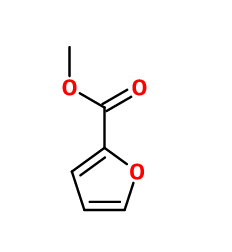Découverte :
Donnée indisponible.
Voies de synthèse :
Le 2-Furoate de Méthyle est synthétisé par réaction d'estérification de l'acide furoïque avec le méthanol, en présence d'un acide fort concentré en petite quantité, comme l'acide chlorhydrique.
Précurseurs de synthèse :
Le 2-Furoate de Méthyle n'est pas utilisé pour synthétiser un autre composé d'intérêt olfactif.
Isoméries :
Le Furoate de Méthyle est isomère de constitution du Maltol. Tous deux font partie de familles de molécules ayant des similitudes olfactives : les furanes et les pyranes. Ils ont tous deux des notes alimentaires et des notes pyrogénées.
Présence dans la nature :
Donnée indisponible.





Commentaires :
For Treemoss and Oakmoss extracts, the restrictions in the Standards are directly linked to the presence of Atranol and Chloroatranol in the finished products. To ensure that those remain below trace levels, the upper concentration levels have not been increased (compared its last publication in the Amendment 43 (2008)). In the presence of Oakmoss extracts, the level of Treemoss in the respective category has to be reduced accordingly, such that the total amount of both extracts does not exceed the maximum permitted level in each category as listed in the table above. If the same fragrance mixture is intended to be used in more than one IFRA Category, then the most restrictive limitation (based on foreseen use concentrations and maximum permitted level) will apply. Treemoss extracts shall not contain more than 0.8% of Dehydroabietic acid (DHA) as a marker of 2% of total resin acids. The concentration of DHA (about 40% of the total resin acids) in Treemoss can be measured with an High Performance Liquid Chromatography (HPLC) reverse phase - spectrofluorometry method. Further, levels of Atranol and Chloroatranol should each be below 100 ppm in Treemoss extracts.